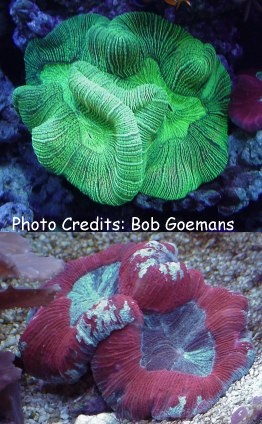
By Bob Goemans

Likely Reef Tank Suitable
Likely Fish-Only Tank Suitable
Range: Indo-West Pacific Ocean: Widespread.
Natural Environment: Initially, this photosynthetic stony coral with large fleshy polyps is attached while quite immature to hard substrates of various kinds. As it grows in weight and size, it breaks free and becomes a free-living coral. Adults are often found on muddy lagoon and reef slope bottoms where gentle water flow and moderate light exists. However, they are also occasionally found on sandy and coral rubble bottoms and/or protected seagrass beds experiencing the same water and light conditions as previously mentioned. Its tentacles are usually displayed at night and will then feed on available plankton. Often found in various color combinations, including highly fluorescent colors, e.g., red, pink, green, and blue.
General Husbandry: This coral is common in the trade and easy to maintain in aquariums if placed in the correction location. This would be an area that receives gentle water flow and moderate light. Those that are red in color should be placed in shady areas or at least those receiving indirect light. Green, tan or brown varieties prefer slightly more light, and should be placed in areas receiving low to moderate direct light.
It is extremely important not to place it where disturbed sand or debris will collect on its surface, as that requires much of the animal's energy to slough it off. It may become weakened if it has to continuously slough off sediment, and then become susceptible to white-band disease or bleaching, and if so, tissue recession soon follows.
Even though feeding tentacles are usually displayed at night, it will also sometimes display them if it senses food entering the aquarium during the daytime. When its feeding tentacles are displayed, recommend directly dosing them with meaty foodstuffs, e.g., fortified brine shrimp, mysis, rotifers, and/or products containing Cyclop-eeze. Feeding, in my opinion, should not occur more than once per week, as more seems to cause odd growth forms, sometimes leading to its demise.
It has been reported that in aquariums containing leather corals such as Sinularia species, Trachyphyllia species do not fair well, possibly because of the chemicals released by Sinularia species. Personally, those in my past aquariums along various Sinularia species have not experienced a similar fate. But its worth mentioning nevertheless.
Taxonomy:
Kingdom: Animalia
Phylum: Cnidaria
Class: Anthozoa
Subclass: Hexacorallia
Order: Scleractinia
Family: Trachyphylliidae
Genus: Trachyphyllia
FYI: Always select a specimen that does not have any kind of alga growth on any of its exposed skeleton surface, as it will cause the tissue to recede, usually leading to the animals demise sooner or later. Furthermore, this species is occasionally found tasty by some tangs and angelfish, so be forewarned. And do not remove a specimen with highly inflated tissue areas from the water as the weight of the water in the polyp may damage or tear its flesh lose from its skeleton. Gently shake the specimen and allow the flesh to retract somewhat before removing.
Experience Level: Beginner
Diet: Carnivior/Plankton feeder
Temperament: Peaceful
Aquarium Environment: Reef or fish-only aquarium
Coral Safe: With caution
Fish Safe: Yes
Invertebrate Safe: With caution
Acclimation Time: 30 minutes+
Aquarium Hardiness: Hardy
Calcium (Ca): 380 - 430 mg/l
Alkalinity: 2.5 - 3.0 meq/l
Phosphate (PO4): <0.05 mg/l
Magnesium (Mg): approx. 1350 mg/l (relate to specific gravity)
Strontium (Sr) 8 - 10 mg/l
Temperature Range: 72 - 82°F (22 - 27°C)
Minimum Tank Size: 50 gallons
Lighting: PAR 250 - 400
Water Movement: WM 2
Specific Gravity: 1.023 - 1.025
pH: 8.0 - 8.4
Iodine/Trace Elements Monitor/as necessary to maintain quality seawater.
